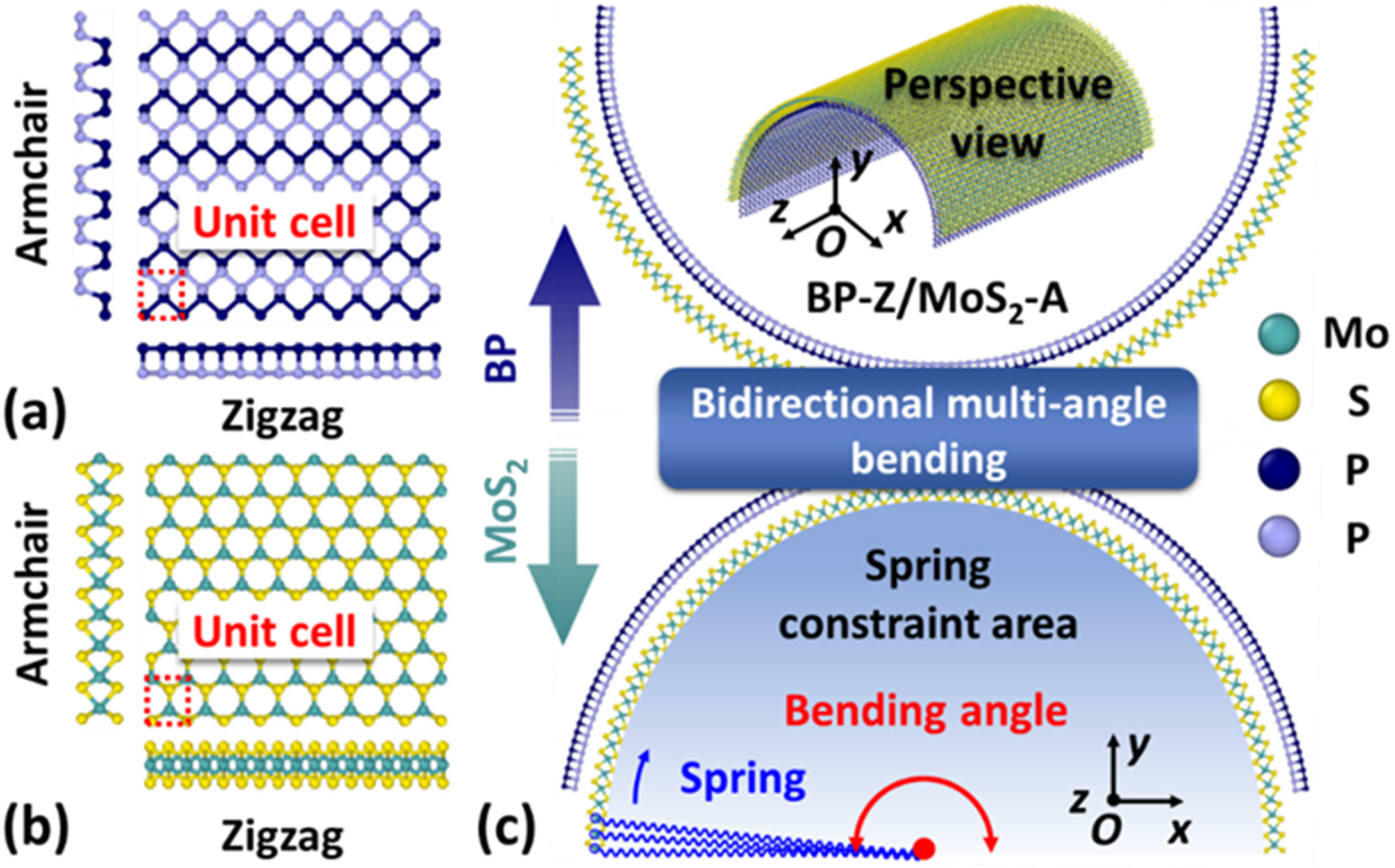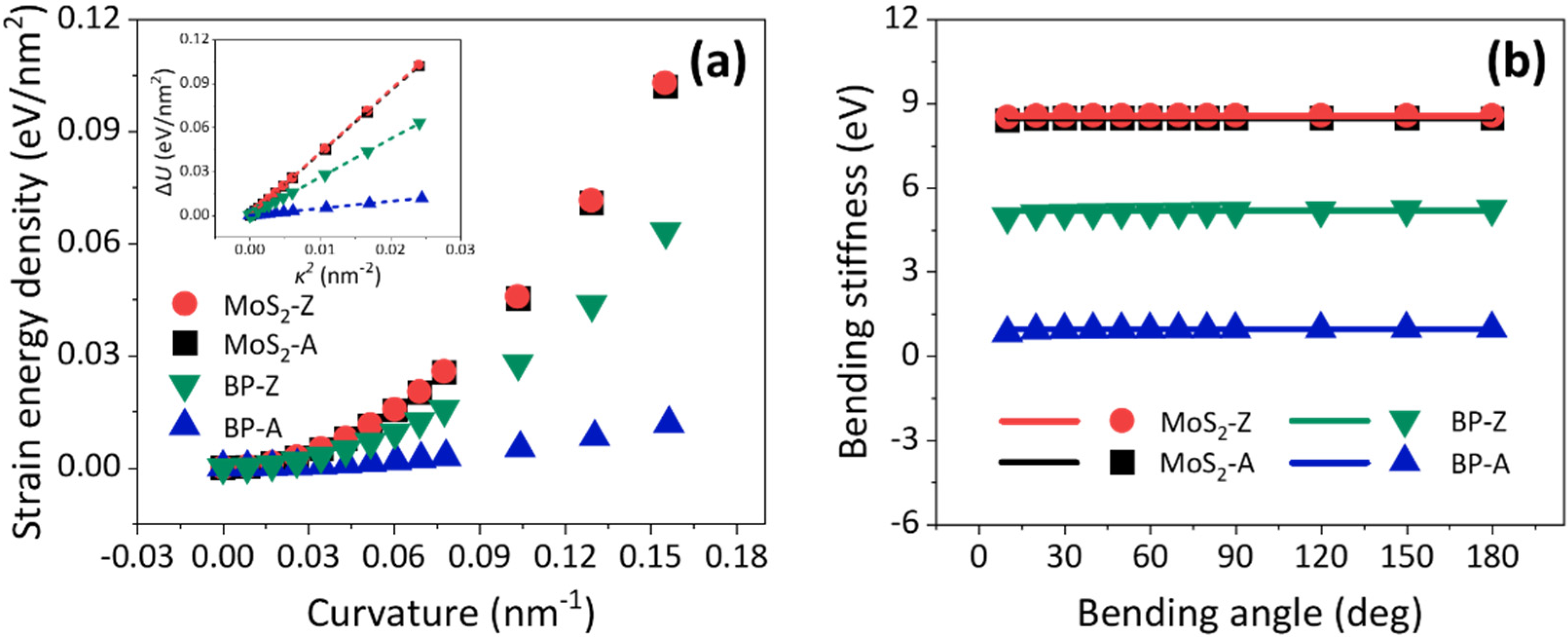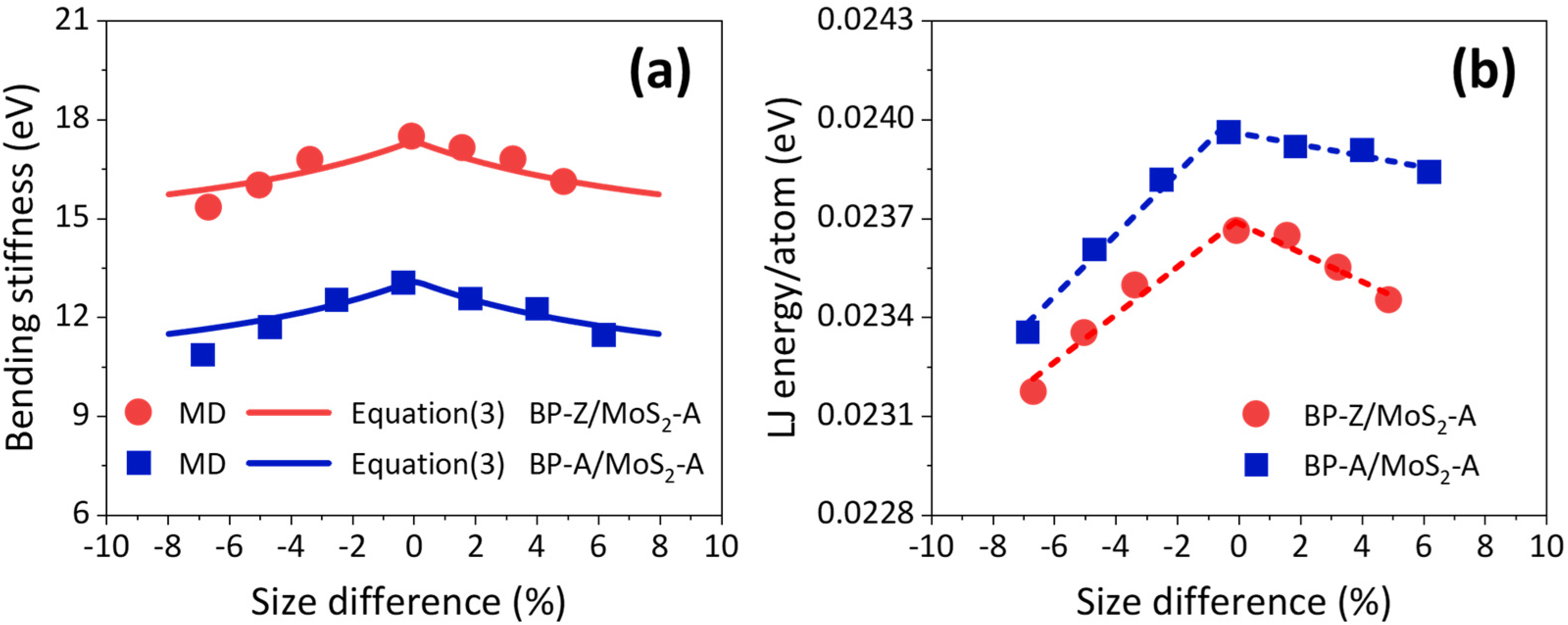Self-Bending Behavior and Varying Bending Stiffness of Black Phosphorus/Molybdenum Disulfide (BP/MoS2) Heterostructure
Abstract
1. Introduction
2. Models and Methodology
2.1. Numerical Models
2.2. Computational Method
2.3. Simulation Details
3. Results and Discussions
3.1. Bending Stiffness
3.2. Size Difference-Induced Self-Bending Behavior
3.3. Size Difference-Induced Weakened Bending Stiffness
3.4. Prediction Formula
4. Conclusions
Author Contributions
Funding
Data Availability Statement
Conflicts of Interest
References
- Novoselov, K.S.; Mishchenko, A.; Carvalho, A.; Castro Neto, A.H. 2D materials and van der Waals heterostructures. Science 2016, 353, aac9439. [Google Scholar] [CrossRef] [PubMed]
- Ares, P.; Novoselov, K.S. Recent advances in graphene and other 2D materials. Nano Mater. Sci. 2022, 4, 3–9. [Google Scholar] [CrossRef]
- Cao, K.; Feng, S.; Han, Y.; Gao, L.; Hue Ly, T.; Xu, Z.; Lu, Y. Elastic straining of free-standing monolayer graphene. Nat. Commun. 2020, 11, 284. [Google Scholar] [CrossRef] [PubMed]
- Chen, X.; Ponraj, J.S.; Fan, D.; Zhang, H. An overview of the optical properties and applications of black phosphorus. Nanoscale 2020, 12, 3513–3534. [Google Scholar] [CrossRef] [PubMed]
- Alam, M.H.; Chowdhury, S.; Roy, A.; Braga, M.H.; Banerjee, S.K.; Akinwande, D. Direct growth of MoS2 on electrolytic substrate and realization of high-mobility transistors. Phys. Rev. Mater. 2021, 5, 054003. [Google Scholar] [CrossRef]
- Li, W.; Tian, W. Molecular Dynamics Analysis of Graphene Nanoelectromechanical Resonators Based on Vacancy Defects. Nanomaterials 2022, 12, 1722. [Google Scholar] [CrossRef]
- Zhang, Z.; Li, S.; Mi, B.; Wang, J.; Ding, J. Surface slip on rotating graphene membrane enables the temporal selectivity that breaks the permeability-selectivity trade-off. Sci. Adv. 2020, 6, eaba9471. [Google Scholar] [CrossRef]
- Wei, N.; Li, Z.; Li, Z.-H.; Zhang, C.; Wang, C.; Zhao, J.; Cai, K. A heat and force locating sensor with nanoscale precision: A knitted graphene sheet. Nanoscale 2021, 13, 5826–5833. [Google Scholar] [CrossRef]
- Jiang, J.-W.; Park, H.S. Negative poisson’s ratio in single-layer black phosphorus. Nat. Commun. 2014, 5, 4727. [Google Scholar] [CrossRef]
- Wang, R.; Ruzicka, B.A.; Kumar, N.; Bellus, M.Z.; Chiu, H.-Y.; Zhao, H. Ultrafast and spatially resolved studies of charge carriers in atomically thin molybdenum disulfide. Phys. Rev. B 2012, 86, 045406. [Google Scholar] [CrossRef]
- Dai, Z.; Lu, N.; Liechti, K.M.; Huang, R. Mechanics at the interfaces of 2D materials: Challenges and opportunities. Curr. Opin. Solid State Mater. Sci. 2020, 24, 100837. [Google Scholar] [CrossRef]
- Cao, Y.; Fatemi, V.; Fang, S.; Watanabe, K.; Taniguchi, T.; Kaxiras, E.; Jarillo-Herrero, P. Unconventional superconductivity in magic-angle graphene superlattices. Nature 2018, 556, 43–50. [Google Scholar] [CrossRef] [PubMed]
- Wu, L.; Sun, X.; Gong, F.; Luo, J.; Yin, C.; Sun, Z.; Xiao, R. Enhanced Thermal Transport Properties of Graphene/SiC Heterostructures on Nuclear Reactor Cladding Material: A Molecular Dynamics Insight. Nanomaterials 2022, 12, 894. [Google Scholar] [CrossRef]
- Deng, Y.; Luo, Z.; Conrad, N.J.; Liu, H.; Gong, Y.; Najmaei, S.; Ajayan, P.M.; Lou, J.; Xu, X.; Ye, P.D. Black Phosphorus–Monolayer MoS2 van der Waals Heterojunction p–n Diode. ACS Nano 2014, 8, 8292–8299. [Google Scholar] [CrossRef]
- Nie, Z.; Wang, Y.; Li, Z.; Sun, Y.; Qin, S.; Liu, X.; Turcu, I.C.E.; Shi, Y.; Zhang, R.; Ye, Y.; et al. Ultrafast free carrier dynamics in black phosphorus–molybdenum disulfide (BP/MoS2) heterostructures. Nanoscale Horiz. 2019, 4, 1099–1105. [Google Scholar] [CrossRef]
- Ye, L.; Li, H.; Chen, Z.; Xu, J. Near-Infrared Photodetector Based on MoS2/Black Phosphorus Heterojunction. ACS Photonics 2016, 3, 692–699. [Google Scholar] [CrossRef]
- Liu, X.; Qu, D.; Li, H.-M.; Moon, I.; Ahmed, F.; Kim, C.; Lee, M.; Choi, Y.; Cho, J.H.; Hone, J.C.; et al. Modulation of Quantum Tunneling via a Vertical Two-Dimensional Black Phosphorus and Molybdenum Disulfide p–n Junction. ACS Nano 2017, 11, 9143–9150. [Google Scholar] [CrossRef] [PubMed]
- Carmesin, C.; Lorke, M.; Florian, M.; Erben, D.; Schulz, A.; Wehling, T.O.; Jahnke, F. Quantum-Dot-Like States in Molybdenum Disulfide Nanostructures Due to the Interplay of Local Surface Wrinkling, Strain, and Dielectric Confinement. Nano Lett. 2019, 19, 3182–3186. [Google Scholar] [CrossRef] [PubMed]
- Cai, K.; Wang, L.; Xie, Y.M. Buckling behavior of nanotubes from diamondene. Mater. Des. 2018, 149, 34–42. [Google Scholar] [CrossRef]
- Akinwande, D.; Brennan, C.J.; Bunch, J.S.; Egberts, P.; Felts, J.R.; Gao, H.; Huang, R.; Kim, J.-S.; Li, T.; Li, Y.; et al. A review on mechanics and mechanical properties of 2D materials—Graphene and beyond. Extreme Mech. Lett. 2017, 13, 42–77. [Google Scholar] [CrossRef]
- Wang, G.; Dai, Z.; Xiao, J.; Feng, S.; Weng, C.; Liu, L.; Xu, Z.; Huang, R.; Zhang, Z. Bending of Multilayer van der Waals Materials. Phys. Rev. Lett. 2019, 123, 116101. [Google Scholar] [CrossRef] [PubMed]
- Blees, M.K.; Barnard, A.W.; Rose, P.A.; Roberts, S.P.; McGill, K.L.; Huang, P.Y.; Ruyack, A.R.; Kevek, J.W.; Kobrin, B.; Muller, D.A.; et al. Graphene kirigami. Nature 2015, 524, 204–207. [Google Scholar] [CrossRef] [PubMed]
- Lindahl, N.; Midtvedt, D.; Svensson, J.; Nerushev, O.A.; Lindvall, N.; Isacsson, A.; Campbell, E.E. Determination of the bending rigidity of graphene via electrostatic actuation of buckled membranes. Nano Lett. 2012, 12, 3526–3531. [Google Scholar] [CrossRef]
- Koskinen, P.; Kit, O.O. Approximate modeling of spherical membranes. Phys. Rev. B 2010, 82, 235420. [Google Scholar] [CrossRef]
- Zhang, D.B.; Akatyeva, E.; Dumitrică, T. Bending Ultrathin Graphene at the Margins of Continuum Mechanics. Phys. Rev. Lett. 2011, 106, 255503. [Google Scholar] [CrossRef] [PubMed]
- Han, E.; Yu, J.; Annevelink, E.; Son, J.; Kang, D.A.; Watanabe, K.; Taniguchi, T.; Ertekin, E.; Huang, P.Y.; van der Zande, A.M. Ultrasoft slip-mediated bending in few-layer graphene. Nat. Mater. 2020, 19, 305–309. [Google Scholar] [CrossRef] [PubMed]
- Huang, R. Bending with slip. Nat. Mater. 2020, 19, 259–260. [Google Scholar] [CrossRef]
- Li, D.; Zheng, Y.; Zhang, H.; Chen, Z.; Ye, H. Commensurate stacking-induced ultrahigh yet discontinuous bending stiffness of the double-layer black phosphorus. Appl. Surf. Sci. 2022, 605, 154729. [Google Scholar] [CrossRef]
- Xia, J.; Yan, J.; Wang, Z.; He, Y.; Gong, Y.; Chen, W.; Sum, T.C.; Liu, Z.; Ajayan, P.M.; Shen, Z. Strong coupling and pressure engineering in WSe2–MoSe2 heterobilayers. Nat. Phys. 2021, 17, 92–98. [Google Scholar] [CrossRef]
- Feng, S.; Xu, Z. Pattern Development and Control of Strained Solitons in Graphene Bilayers. Nano Lett. 2021, 21, 1772–1777. [Google Scholar] [CrossRef] [PubMed]
- Argentero, G.; Mittelberger, A.; Monazam, M.R.A.; Cao, Y.; Pennycook, T.J.; Mangler, C.; Kramberger, C.; Kotakoski, J.; Geim, A.K.; Meyer, J.C. Unraveling the 3D Atomic Structure of a Suspended Graphene/hBN van der Waals Heterostructure. Nano Lett. 2017, 17, 1409–1416. [Google Scholar] [CrossRef]
- Jiang, J.-W.; Park, H.S. Mechanical properties of MoS2/graphene heterostructures. Appl. Phys. Lett. 2014, 105, 033108. [Google Scholar] [CrossRef]
- Bao, H.; Huang, Y.; Ma, F.; Yang, Z.; Miao, Y.; Xu, K.; Chu, P.K. Size-Dependent elastic modulus of single-layer MoS2 nano-sheets. J. Mater. Sci. 2016, 51, 6850–6859. [Google Scholar] [CrossRef]
- Wei, N.; Chen, Y.; Zhang, Y.; Zhou, C.; Hao, X.; Xu, K.; Cai, K.; Chen, J. Efficient selection methods for black phosphorene nanoribbons. Nanoscale 2018, 10, 4385–4390. [Google Scholar] [CrossRef] [PubMed]
- Zhang, Z.-Q.; Liu, H.-L.; Liu, Z.; Zhang, Z.; Cheng, G.-G.; Wang, X.-D.; Ding, J.-N. Anisotropic interfacial properties between monolayered black phosphorus and water. Appl. Surf. Sci. 2019, 475, 857–862. [Google Scholar] [CrossRef]
- Zhang, Z.; Ouyang, G. Band Modulation of Black Phosphorus and Molybdenum Disulfide van der Waals Heterojunction: Twist and Electric Field Effects. ACS Appl. Energy Mater. 2018, 1, 5675–5684. [Google Scholar] [CrossRef]
- Huang, L.; Huo, N.; Li, Y.; Chen, H.; Yang, J.; Wei, Z.; Li, J.; Li, S.-S. Electric-Field Tunable Band Offsets in Black Phosphorus and MoS2 van der Waals p-n Heterostructure. J. Phys. Chem. Lett. 2015, 6, 2483–2488. [Google Scholar] [CrossRef] [PubMed]
- Nepal, N.K.; Yu, L.; Yan, Q.; Ruzsinszky, A. First-Principles study of mechanical and electronic properties of bent monolayer transition metal dichalcogenides. Phys. Rev. Mater. 2019, 3, 073601. [Google Scholar] [CrossRef]
- Jiang, J.W.; Park, H.S.; Rabczuk, T. Molecular dynamics simulations of single-layer molybdenum disulphide (MoS2): Stillinger-Weber parametrization, mechanical properties, and thermal conductivity. J. Appl. Phys. 2013, 114, 064307. [Google Scholar] [CrossRef]
- Jiang, J.W. Parametrization of Stillinger-Weber potential based on valence force field model: Application to single-layer MoS2 and black phosphorus. Nanotechnology 2015, 26, 315706. [Google Scholar] [CrossRef] [PubMed]
- Xiong, S.; Cao, G. Bending response of single layer MoS2. Nanotechnology 2016, 27, 105701. [Google Scholar] [CrossRef] [PubMed]
- Delhommelle, J.; MilliÉ, P. Inadequacy of the Lorentz-Berthelot combining rules for accurate predictions of equilibrium properties by molecular simulation. Mol. Phys. 2001, 99, 619–625. [Google Scholar] [CrossRef]
- Liang, T.; Phillpot, S.R.; Sinnott, S.B. Parametrization of a reactive many-body potential for Mo--S systems. Phys. Rev. B 2009, 79, 245110. [Google Scholar] [CrossRef]
- Zhang, Y.-Y.; Pei, Q.-X.; Jiang, J.-W.; Wei, N.; Zhang, Y.-W. Thermal conductivities of single- and multi-layer phosphorene: A molecular dynamics study. Nanoscale 2016, 8, 483–491. [Google Scholar] [CrossRef]
- Yu, J.; Han, E.; Hossain, M.A.; Watanabe, K.; Taniguchi, T.; Ertekin, E.; van der Zande, A.M.; Huang, P.Y. Designing the bending stiffness of 2D material heterostructures. Adv. Mater. 2021, 33, 2007269. [Google Scholar] [CrossRef]





| Type | BP-A | BP-Z | MoS2-A | MoS2-Z |
| Length (Å) | 200.00 | 200.55 | 200.70 | 201.00 |
| Type | BP-A/MoS2-A | BP-Z/MoS2-A | BP-A/MoS2-Z | BP-Z/MoS2-Z |
| SD (%) | −0.35 | −0.07 | −0.50 | −0.22 |
| Parameters | Mo-Mo [43] | S-S [43] | P-P [44] | Mo-P | S-P |
|---|---|---|---|---|---|
| σ (Å) | 4.20 | 3.13 | 3.695 | 3.9475 | 3.4125 |
| ε (eV) | 0.000586 | 0.01386 | 0.0132 | 0.002781 | 0.013526 |
| Type | MD (eV) | Prediction (eV) | Error (%) | |
|---|---|---|---|---|
| BP-A/MoS2-A | 0.70 | 13.06 | 12.99 | 0.54 |
| BP-Z/MoS2-A | 0.15 | 17.49 | 17.32 | 0.97 |
| BP-A/MoS2-Z | 1.00 | 13.18 | 12.03 | 1.14 |
| BP-Z/MoS2-Z | 0.45 | 17.38 | 17.36 | 0.12 |
Publisher’s Note: MDPI stays neutral with regard to jurisdictional claims in published maps and institutional affiliations. |
© 2022 by the authors. Licensee MDPI, Basel, Switzerland. This article is an open access article distributed under the terms and conditions of the Creative Commons Attribution (CC BY) license (https://creativecommons.org/licenses/by/4.0/).
Share and Cite
Li, D.; Zheng, Y.; Zhang, H.; Ye, H. Self-Bending Behavior and Varying Bending Stiffness of Black Phosphorus/Molybdenum Disulfide (BP/MoS2) Heterostructure. Nanomaterials 2022, 12, 3635. https://doi.org/10.3390/nano12203635
Li D, Zheng Y, Zhang H, Ye H. Self-Bending Behavior and Varying Bending Stiffness of Black Phosphorus/Molybdenum Disulfide (BP/MoS2) Heterostructure. Nanomaterials. 2022; 12(20):3635. https://doi.org/10.3390/nano12203635
Chicago/Turabian StyleLi, Dong, Yonggang Zheng, Hongwu Zhang, and Hongfei Ye. 2022. "Self-Bending Behavior and Varying Bending Stiffness of Black Phosphorus/Molybdenum Disulfide (BP/MoS2) Heterostructure" Nanomaterials 12, no. 20: 3635. https://doi.org/10.3390/nano12203635
APA StyleLi, D., Zheng, Y., Zhang, H., & Ye, H. (2022). Self-Bending Behavior and Varying Bending Stiffness of Black Phosphorus/Molybdenum Disulfide (BP/MoS2) Heterostructure. Nanomaterials, 12(20), 3635. https://doi.org/10.3390/nano12203635








